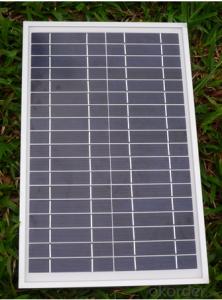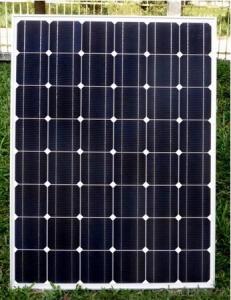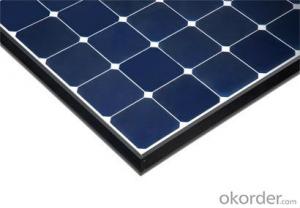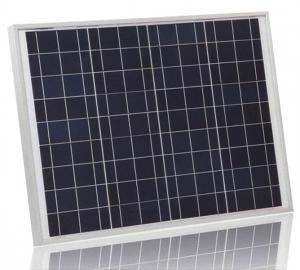Overlanding Solar Panels:Mono Solar Panel 305W A Grade with Cheapest Price
- Loading Port:
- Shanghai
- Payment Terms:
- TT OR LC
- Min Order Qty:
- 50 watt
- Supply Capability:
- 50000 watt/month
OKorder Service Pledge
OKorder Financial Service
You Might Also Like
Specification
Mono Solar Panel 305W A Grade with Cheapest Price
Product description
60 cell multi-crystalline solar module. 40mm natural anodised frame. IP65 rated Jbox, 1m solar cable and a pair of MC4 connectors.TÜV SÜD,SABS ISO 9001:2008 certified.
Module performance is generally rated under standard test conditions (STC): irradiance of 1,000 W/m², solar spectrum of AM 1.5 and module temperature at 25 °C.
Electrical characteristics include nominal power (PMAX, measured in W), open circuit voltage (VOC), short circuit current (ISC, measured in amperes), maximum power voltage (VMPP), maximum power current (IMPP), peak power, (watt-peak, Wp), and module efficiency (%).

Application
Industrial
Commercial
Residential
Product feather
solar panel refers to a panel designed to absorb the sun's rays as a source of energy for generating electricity or heating.
A photovoltaic (in short PV) module is a packaged, connected assembly of typically 6×10 solar cells. Solar Photovoltaic panels constitute the solar array of a photovoltaic system that generates and supplies solar electricityin commercial and residential applications. Each module is rated by its DC output power under standard test conditions, and typically ranges from 100 to 365 watts. The efficiency of a module determines the area of a module given the same rated output – an 8% efficient 230 watt module will have twice the area of a 16% efficient 230 watt module. There are a few solar panels available that are exceeding 19% efficiency. A single solar module can produce only a limited amount of power; most installations contain multiple modules. A photovoltaic system typically includes a panel or an array of solar modules, a solar inverter, and sometimes a battery and/or solar tracker and interconnection wiring.
Packaging
24-26pcs into carton 312pcs for 20 foot container 712pcs for 40 foot container.
- Q: How do solar panels affect home resale value?
- Solar panels can increase the resale value of a home due to their potential cost savings and environmental benefits. Studies have shown that homes equipped with solar panels tend to sell faster and at higher prices compared to similar properties without solar installations.
- Q: Can solar panels be installed on a retirement home or assisted living facility?
- Yes, solar panels can be installed on a retirement home or assisted living facility. In fact, many such facilities are embracing solar energy as a sustainable and cost-effective solution. Installing solar panels can help reduce energy costs, decrease reliance on the grid, and contribute to a greener environment, all while providing clean energy for the residents.
- Q: where I can find solar panel the has 4.8 volts? Like those solar walkway light or something that has 4.8 volts solar panel.Do you think I can get it from home depot?
- How Solar Cells Work by Scott Aldous Inside This Article . Introduction to How Solar Cells Work 2. Photovoltaic Cells: Converting Photons to Electrons 3. How Silicon Makes a Solar Cell 4. Anatomy of a Solar Cell 5. Energy Loss in a Solar Cell 6. Solar-powering a House 7. Solving Solar-power Issues 8. Solar-power Pros and Cons 9. Lots More Information 0. See all Physical Science articles You've probably seen calculators that have solar cells -- calculators that never need batteries, and in some cases don't even have an off button. As long as you have enough light, they seem to work forever. You may have seen larger solar panels -- on emergency road signs or call boxes, on buoys, even in parking lots to power lights. Although these larger panels aren't as common as solar powered calculators, they're out there, and not that hard to spot if you know where to look. There are solar cell arrays on satellites, where they are used to power the electrical systems. You have probably also been hearing about the solar revolution for the last 20 years -- the idea that one day we will all use free electricity from the sun. This is a seductive promise: On a bright, sunny day, the sun shines approximately ,000 watts of energy per square meter of the planet's surface, and if we could collect all of that energy we could easily power our homes and offices for free.
- Q: Can solar panels be installed on a residential community or housing complex?
- Yes, solar panels can be installed on a residential community or housing complex. In fact, many residential communities and housing complexes are increasingly adopting solar energy as a sustainable and cost-effective power source. Installing solar panels can help generate clean and renewable electricity, reduce energy bills, and contribute to a greener environment.
- Q: i want to build a stationary model of a solar panel and i dont know if it is going to be too simple or not i also want ideas to make it betterplease criticism is allowedmy idea was to make a case, just like a real solar panel, and take plexiglass to make it. i want to add some models of photovoltaic cells that look like they are in a solar panel . i want to add the fake shoulderings as well . i want to make the case openable by hinges.i would like some of your thoughts and ideas to help me .thx
- Build okorder /
- Q: I need help?!!
- They are costly, although technology is improving. To generate enough current to be useful, the panel needs to be large quite large. The sun tracks at different angles depending on the season and the solar panel would need to be repositioned to get maximum current generation because of this.
- Q: A homeowner is considering putting a horizontal solar panel on her roof to heat water for domestic use. An average increase of water temperature each day from 60oF to 20oF is wanted for 50 gallons. How large a panel would be needed on a clear winter day at 40o latitude if the overall efficiency is 50%?
- Here's a typical 4' x 8' collector rating. 40 degree latitude would be a cool climate, so you look at row D, water heating in a cool climate. Probably take the middle rating, mildly sunny day, and it is 0,000BTU per panel per day (it's 9,000 on a sunny day). 38,700 BTU / 0,000 BTU = 3.87, they'd need about 3 to 4 panels. If you used the sunny day number, you'd only need 2, but 3 is more realistic, as it is not always a sunny day.
- Q: Green issues aside, are solar panels worth it, monetarily speaking?I don't mean that my house might be worth more or any of that. All I am asking is this: if I invest in a set of solar panels, will the cost be paid back to me over time? If so, how long will it takegt;Take into account the following:. Currently I pay the electric company around $00 per month2. I use around 400 kilowats of energy per monthI realize that exact numbers are hard to come by, but any opinions are welcome.
- There are several factors to consider when looking into solar power for your house. If you want to replace your use of utility electricity with solar power for say a 500 - 2000 square foot home then the system will cost you at least $30000 - $50000 to install. You will also have the maintenance issue of your storage batteries, panels, and inverter which will eventually wear out over time. So lets say we have an optimistic price of $30000 for a whole house system (this would be really cheap), dividing this by your yearly consumption would give you the amount of years it would take for the expenditure to pay for itself (not counting maintenance which could be costly). The payoff would be about 25 years, so all things remaining equal, I would say that it is a bad investment. Solar panels as they are manufactured today do not have a very long life span. They will greatly decrease in efficiency after several years and will most likely need to be replaced in 0 years. The panels themselves are the greatest expense. You could problably find better ways to make/save more money by investing $30000 - $50000 somewhere else IMHO. Solar technology is still not at the point where it is profitable in the sense you are thinking about. Unless of course, there are huge tax incentives for you or large rebate programs through your local utility, but you would have to do the math on that as well. If you are thinking small as in a couple panels to supplement your utility electric, the above still applies as well. In fact will it take longer to recoup the cost of a smaller setup. Hope this helps!
- Q: how long till a 50 watt solar panel pays itself off in buffalo, ny if its $500. i have national grid and heres the link to the rates. i am residential.
- I have a small system and do not make enough to sell back (no batteries) so it was less than 7 years BUT when you are talking about putting the initial in to a high yield div account and comparing it then I would say it took only 4 years to pay for because I was invested like many others with the capital it would have taken to get a large system and that investment LOST money while my solar pays for itself every year bit by bit. With systems now more efficient and rebates bigger and the investment alternatives not any better it is an easy choice.
- Q: How many solar panels do you need on your house to power your heater in winter?
- Your house, and probably your yard wouldn't be big enough to hold them. I did this exercise once (not doing it again) for someone who wanted to replace his 6hp outboard motor with a solar powered one. The calculations ended up that he would need something like .5 acres of solar panels to get that much energy. Not happening. That said, an passive solar home, can get a significant amount of warmth from the sun directly. But it doesn't work very well at night, when it's coldest. (wonder why that is... probably a climate scientist could help us with that? -- oh, wait. They say warming doesn't have anything to do with the sun.) Edit. I didn't use theoretical stuff to come up with my numbers, I used the claims of actual off-the-shelf solar panels sold by West Marine, calculated the power, and did the math based on existing panels.
Send your message to us
Overlanding Solar Panels:Mono Solar Panel 305W A Grade with Cheapest Price
- Loading Port:
- Shanghai
- Payment Terms:
- TT OR LC
- Min Order Qty:
- 50 watt
- Supply Capability:
- 50000 watt/month
OKorder Service Pledge
OKorder Financial Service
Similar products
Hot products
Hot Searches
Related keywords


























